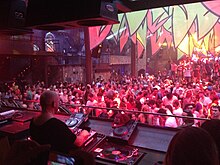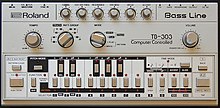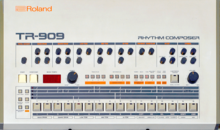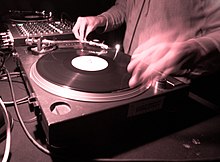
A | B | C | D | E | F | G | H | CH | I | J | K | L | M | N | O | P | Q | R | S | T | U | V | W | X | Y | Z | 0 | 1 | 2 | 3 | 4 | 5 | 6 | 7 | 8 | 9
 DJ Sven Väth mixes tracks for a crowd of dancers at Amnesia, an Ibiza nightclub, in 2013. | |
| General Information | |
|---|---|
| Location | Worldwide |
| Types of street rave dance | |
| Events | |
| Topics | |
| Origin | |
| History |
|
A rave (from the verb: to rave) is a dance party at a warehouse, club, or other public or private venue, typically featuring performances by DJs playing electronic dance music. The style is most associated with the early 1990s dance music scene when DJs played at illegal events in musical styles dominated by electronic dance music from a wide range of sub-genres, including drum and bass, dubstep, trap, break, happy hardcore, trance, techno,[1] hardcore, house,[1] and alternative dance. Occasionally live musicians have been known to perform at raves, in addition to other types of performance artists such as go-go dancers and fire dancers. The music is amplified with a large, powerful sound reinforcement system, typically with large subwoofers to produce a deep bass sound. The music is often accompanied by laser light shows, projected coloured images, visual effects and fog machines.
While some raves may be small parties held at nightclubs or private homes, some raves have grown to immense size, such as the large festivals and events featuring multiple DJs and dance areas (e.g., the Castlemorton Common Festival in 1992). Some electronic dance music festivals have features of raves, but on a larger, often commercial scale. Raves may last for a long time, with some events continuing for twenty-four hours, and lasting all through the night. Law enforcement raids and anti-rave laws have presented a challenge to the rave scene in many countries.[2] This is due to the association of rave culture with illegal drugs such as MDMA[3][4] (often referred to as a "club drug" or "party drug" along with MDA[5]), amphetamine, LSD,[3][4] GHB,[3][4] ketamine,[3][4][6] methamphetamine,[3][4] cocaine,[4] and cannabis.[7] In addition to drugs, raves often make use of non-authorized, secret venues, such as squat parties at unoccupied homes,[8] unused warehouses,[9] or aircraft hangars.[10][11] These concerns are often attributed to a type of moral panic surrounding rave culture.[12]
History
Origin (1950s–1970s)
In the late 1950s in London, England, the term "rave" was used to describe the "wild bohemian parties" of the Soho beatnik set.[13] Jazz musician Mick Mulligan, known for indulging in such excesses, had the nickname "king of the ravers".[14] In 1958, Buddy Holly recorded the hit "Rave On", citing the madness and frenzy of a feeling and the desire for it never to end.[15] The word "rave" was later used in the burgeoning mod youth culture of the early 1960s as the way to describe any wild party in general. People who were gregarious party animals were described as "ravers". Pop musicians such as Steve Marriott of Small Faces and Keith Moon of The Who were self-described "ravers".[16] In 1965, the Grateful Dead served as the backing band for the San Francisco Acid Tests, which were LSD drug parties organized by Ken Kesey. Subsequently, visual artist Andy Warhol later organized the Exploding Plastic Inevitable[17] in New York, a multimedia event backed with performances by the Velvet Underground and Nico, the event was characterized by flashing lights, loud music, dancing and heavy drug use.[18] During the psychedelic era, happenings became a common fixture of the counterculture. This later culminated in the massive social phenomenon known as the Summer of Love.[19] The phrase "Summer of Love" was used once again during the advent of rave culture in the 1980s, referring to the "Second Summer of Love."

Presaging the word's subsequent 1980s association with electronic music, the word "rave" was a common term used regarding the music of mid-1960s garage rock and psychedelia bands (most notably The Yardbirds, who released an album in the United States called Having a Rave Up). Along with being an alternative term for partying at such garage events in general, the "rave-up" referred to a specific crescendo moment near the end of a song where the music was played faster, more heavily and with intense soloing or elements of controlled feedback. It was later part of the title of an electronic music performance event held on 28 January 1967 at London's Roundhouse titled the "Million Volt Light and Sound Rave". The event featured the only known public airing of an experimental sound collage created for the occasion by Paul McCartney of The Beatles – the legendary "Carnival of Light" recording.[20]
With the rapid change of British pop culture from the mod era of 1963–1966 to the hippie era of 1967 and beyond, the term fell out of popular usage. The Northern soul movement is cited by many as being a significant step towards the creation of contemporary club culture and of the superstar DJ culture of the 2000s.[21] As in contemporary club culture, Northern soul DJs built up a following based on satisfying the crowd's desires for music that they could not hear anywhere else. Many argue that Northern soul was instrumental in creating a network of clubs, DJs, record collectors and dealers in the UK, and was the first music scene to provide the British charts with records that sold entirely on the strength of club play.[22] A technique employed by northern soul DJs in common with their later counterparts was the sequencing of records to create euphoric highs and lows for the crowd; DJ Laurence 'Larry' Proxton was known for using this method. DJ personalities and their followers involved in the original Northern soul movement went on to become important figures in the house and dance music scenes.[23] During the 1970s and early 1980s until its resurrection, the term was not in vogue, one notable exception being in the lyrics of the song "Drive-In Saturday" by David Bowie (from his 1973 album Aladdin Sane) which includes the line, "It's a crash course for the ravers." Its use during that era would have been perceived as a quaint or ironic use of bygone slang: part of the dated 1960s lexicon along with words such as "groovy".
The perception of the word "rave" changed again in the late 1980s when the term was revived and adopted by a new youth culture, possibly inspired by the use of the term in Jamaica.[13]
Acid house (1980s)

In the mid to late 1980s, a wave of psychedelic and other electronic dance music, most notably acid house music, emerged from acid house music parties in the mid-to-late 1980s in the Chicago area in the United States.[24] After Chicago acid house artists began experiencing overseas success, acid house quickly spread and caught on in the United Kingdom[25][26] within clubs, warehouses and free-parties, first in Manchester in the mid-1980s and then later in London. In the late 1980s, the word "rave" was adopted to describe the subculture that grew out of the acid house movement.[27] Activities were related to the party atmosphere of Ibiza, a Mediterranean island in Spain, frequented by British, Italian, Greek, Irish and German youth on vacation, who would hold raves and dance parties.[28]
Growth (1990s–present)
By the 1990s, genres such as acid, breakbeat hardcore, hardcore, happy hardcore, gabber, drum & bass, post-industrial and electronica were all being featured at raves, both large and small. There were mainstream events which attracted thousands of people (up to 25,000[29] instead of the 4,000 that came to earlier warehouse parties). Acid house music parties were first re-branded "rave parties" in the media, during the summer of 1989 by Genesis P-Orridge during a television interview; however, the ambience of the rave was not fully formed until the early 1990s. In 1990, raves were held "underground" in several cities, such as Berlin, Milan and Patras, in basements, warehouses and forests.[30]
British politicians responded with hostility to the emerging rave party trend. Politicians spoke out against raves and began to fine promoters who held unauthorised parties. Police crackdowns on these often unauthorised parties drove the rave scene into the countryside. The word "rave" somehow caught on in the UK to describe common semi-spontaneous weekend parties occurring at various locations linked by the brand new M25 London orbital motorway that ringed London and the Home Counties; it was this that gave the band Orbital their name. These ranged from former warehouses and industrial sites in London, to fields and country clubs in the countryside.
Characteristics
Music



Rave music may either refer to the late 1980s/early 1990s genres of house, new beat, breakbeat, acid house, techno and hardcore techno, which were the first genres of music to be played at rave parties, or to any other genre of electronic dance music (EDM) that may be played at a rave.
The genre "rave", also known as hardcore (not to be confused with hardcore punk) by early ravers, first appeared amongst the UK "acid" movement during the late 1980s at warehouse parties and other underground venues, as well as on UK pirate radio stations.[31] Another genre called "rave" during the early 1990s, was the Belgian hardcore techno music that emerged from new beat, when techno became the main style in the Belgian EDM scene.[32]
The "rave" genre would develop into oldschool hardcore, which lead onto newer forms of rave music such as drum and bass, 2-step and happy hardcore as well as other hardcore techno genres, such as gabber and hardstyle.[33]
Rave music is usually presented in a DJ mix set, although live performances are not uncommon.
Styles of music include:
- House music: House music, especially acid house, is the first genre of music to be played at the earliest raves, during the Second Summer of Love. House is a genre of electronic dance music that originated out of the 1980s African-American and Latino disco scene in Chicago.[34] House music uses a constant bass drum on every beat, electronic drum machine hi-hats and synth basslines. There are many subgenres of house music (found below). Since house was originally club music, there are many forms of it, some more appropriate to be played at raves than others. In the UK, subgenres such as UK funky, speed garage and dubstep emerged from garage house. Many "pop house" club music producers branded themselves as "house music", however, so in rave culture it is often disputed whether pop house should be considered as a subgenre of house. "Rave house" is a subgenre label of house music that originated from the styles of house that were typically played in the rave scene of the 1993–1999 period. It is a term used by the general population who do not follow the house or trance scene specifically, but identify certain house records as "rave music". It is a loose term that generally identifies progressive house, hard house or trance house styles (often instrumental with no words) that one would imagine being played at a large rave.
- Drum and bass: Drum and bass music refers to a music genre with a very specific sound of four significant notes called breakbeat, that serves as a bassline for the song – that's why most drum and bass songs use 170 – 176 BPM, most frequently specifically 174 BPM. Drum and bass includes multiple large subgenres, those who are frequently played at raves include liquid (known for harmonic vocals, less aggressive bass drops and emotional atmosphere), classic dancefloor (energetic and overall positive party music, sometimes even drum and bass remixes of popular songs), jump-up (a less complicated beat, sometimes using machine-like sounds, amplified for consumers of heavier music) and neurofunk (almost sci-fi like subgenre of a heavy and dark drum and bass, only rarely using well-known samples or even traditional music melodies).
- Trance music: Trance music in its most popular and modern form is an offshoot of house music that originated from the acid house movement and rave scene in the late 1980s. The history of trance music is complicated to refer to, as multiple generations of listeners and musicians have influenced the genre. The term "trance" was (and still to this day by many) used interchangeably with "progressive house" in the early rave years (1990–1994).
- Breakbeat: Breakbeat music (or breaks for short) refers to any form of rave music with breakbeats, this may range from breakbeat hardcore to nu skool breaks, including genres such as hardstep and breakcore cross over into the hardcore techno sound. Fusions of house and trance also exist but the drum 'n' bass still remains the most popular form of breakbeat played at rave parties.
- Electro: Electro and techno are two genres which largely featured psychedelic sounds and are largely considered the earliest forms of electronic dance music genres to use the term "rave music" in respect to its modern terminological use. Techno sometimes crosses boundaries with house music, hence the genres trance and acid techno. Miami bass and crunk is sometimes included as "electro".
- Hardcore techno: Any hard dance genre that was influenced by the rave genre, usually these genres have a distorted kick drum, and a 4/4 rhythm. Happy hardcore blended the Dutch hardcore sound with Eurodance and bubblegum pop, the genre (also known as "happycore" for short) featured pitched-up vocals and a less distorted 4/4 beat. Trancecore also exists and is a less vocal fusion of happy hardcore with trance music, however hardstyle is a more pure form of the trance/hardcore genre since it retains the hardcore sound.
- Industrial dance: Industrial is a goth/rock/punk related genre. While the genre is not usually considered rave music in itself, it is often fused with rave music genres. Industrial is the origin of many sounds found in rave music; it is one of the first genres that took the sounds that are now popular in rave music such as "acid" as its musical backdrop. Industrial music fans are usually considered rivetheads and do not tend to call themselves ravers.
- Free tekno: This style of electronic music started in the early 1990s and was mostly played in illegal parties hosted by sound systems, such as Spiral Tribe, Desert Storm, Hekate, Heretik, in warehouse, dismissed buildings, or even illegal open-air festivals, called Teknivals. It takes inspiration from various other genres, and mainly focuses on quick beats, 170/200 bpm, acid bassline, mentals sounds, and often samples taken from movies, popular songs or many other different media sources.
Downtempo and less dance-oriented styles which are sometimes called chill-out music, that might be heard in a rave "chill-out" room or at a rave that plays slower electronic music includes:
- Ambient, minimalist & computer music – Brian Eno, Mike Oldfield, Harold Budd, ATB, The Orb, Biosphere
- Dubstep & breakstep – Magnetic Man, Eskmo, Icicle, Loefah, Phaeleh & Burial
- Electro, glitch, techno, experimental hip hop & industrial hip hop – Flying Lotus, Juan Atkins, MARRS, Dopplereffekt, Egyptian Lover, Afrika Bambaataa, Techno Animal, Coldcut, The Glitch Mob & Kraftwerk
- IDM – Aphex Twin, Autechre & Boards of Canada
- UK garage & grime – Todd Edwards, Grant Nelson, Sunship, Wookie, So Solid Crew, Roll Deep, Dizzee Rascal, Wiley, Plastician
Location

Raves have historically referred to grassroots organised, anti-establishment and unlicensed all‐night dance parties.[35] Prior to the commercialisation of the rave scene, when large legal venues became the norm for these events, the location of the rave was kept secret until the night of the event, usually being communicated through answering machine messages,[36] mobile messaging, secret flyers, and websites. This level of secrecy, necessary for avoiding any interference by the police, also on account of the illicit drug use, enabled the ravers to use locations they could stay in for ten hours at a time. It promoted the sense of deviance and removal from social control.[37] In the 2000s, this level of secrecy still exists in the underground rave scene. However "after-hours" clubs, as well as large outdoor events, create a similar type of alternate atmosphere, but focus much more on vibrant visual effects, such as props and décor. In more recent years,[when?] large commercial events are held at the same locations year after year with similar reoccurring themes every year. Events like Electric Daisy Carnival and Tomorrowland are typically held at the same venue that holds mass numbers of people.
Some raves make use of pagan symbolism. Modern raving venues attempt to immerse the raver in a fantasy-like world. Indigenous imagery and spirituality can be characteristic in the Raving ethos. In both the New Moon and Gateway collectives, "pagan altars are set up, sacred images from primitive cultures decorate the walls, and rituals of cleansing are performed over the turntables and the dance floor"[38] This type of spatial strategy is an integral part of the raving experience because it sets the initial "vibe" in which the ravers will immerse themselves. This said "vibe" is a concept in the raver ethos that represents the allure and receptiveness of an environment's portrayed and or innate energy. The landscape is an integral feature in the composition of rave, much like it is in pagan rituals. For example, The Numic Ghost Dancers rituals were held on specific geographical sites, considered to hold powerful natural flows of energy. These sites were later represented in the rhythmic dances, to achieve a greater level of connectivity.[39]
The Falls festival in Byron Bay features a rave party hidden behind a washing machine in a laundromat.[40]
Notable venues
The following is an incomplete list of venues associated with the rave subculture:
Europe
- Belgium:
- Croatia:
- England:
- Angels (1989–96)
- Astoria
- Bagleys (later Canvas) (1991–2007)
- Cream (1992–2015)
- Epping Forest Country Club
- Fabric (1999–present)
- Camden Palace (1982–2004)
- Gatecrasher One (1996–2007)
- Godskitchen (1996)
- Heaven (1979–present)
- Home (1998–2001)
- Koko (2004–present)
- Konspiracy (1989–90)
- Labrynth (1990–1998)
- Lakota (1990–present)
- Ministry of Sound (1991–present)
- Mint Club (1998–2019)
- Matter
- Megatripolis (1993–96)
- Popscene
- Quadrant Park (1988–91)
- Renaissance (1992)
- Sanctuary Music Arena (1991–2004)
- Sankeys (1994–present)
- Shelley's Laserdome (1989–1995)
- Shoom (1987–1990)[41]
- Sterns Nightclub (1991–1998)
- The Academy (1990–2006)
- The Eclipse (later Edge) (1990–1994)
- The End (1995–2009)
- The Fridge (1981–2010)
- The Haçienda (1982–1997)
- The Zap (1984–2005)
- Thunderdome (1989–90)
- Trade (1990–2008)
- Turnmills (1990–2008)
- Vague (club) (1993–1996)
- France:
- Germany:
- Babalu Club (1990–1994)
- Berghain (2004–present)
- Bunker (1992–1996)
- Dorian Gray (1978–2000)
- E-Werk (1993–1997)
- KitKatClub (1994–present)
- KW – Das Heizkraftwerk (1996–2003)
- Natraj Temple (1996–2008)
- Omen (1988–1998)
- Palazzo (1989–2003)
- Stammheim (1994–2002)
- Tresor (1991–present)
- U60311 (1998–2012)
- Ufo (1988–1990)
- Ultraschall (1994–2003)
- Georgia:
- Ireland:
- Italy:
- The Netherlands:
- Poland:
- Ekwador (1998–2014, 2015–present)
- Romania:
- Russia:
- Quadro (1995–2004)
- Scotland:
- The Arches (1991–2015)
- Hangar 13 (1993–95)[42]
- Sub Club (1987–present)
- The Tunnel (1990–2014)
- Serbia:
- Tunnel
- Slovakia:
- Slovenia:
- Spain:
- Amnesia (1976–present)
- Cream Ibiza
- DC10
- Pacha Group (1967–present)
- Privilege Ibiza (1978–present)
- Sankeys
- Space Ibiza (1986–2016)
- Sweden:
- Docklands (1995–2002)
- Greece:
- Cavo Paradiso Club Mykonos (1993–present)
Middle East
- Egypt:
- Israel:
- Lebanon:
North America
- Canada:
- 23 Hop (1990–1995)
- Industry nightclub (1996–2000)[43]
- Stereo nightclub
- System Soundbar (1999–2005)[44]
- The Comfort Zone (1996–2017)[45]
- The Guvernment (1996–2015)
- Turbo Niteclub (2000–2003)[46]
- Mexico:
- United States:
- Aahz/Beacham Theater (1988–1994)
- Catacombs Nightclub Philadelphia (1978–1986)
- Club Glow
- Club Zanzibar (1979–1993)
- Masterdome (1996–2001)
- Paradise Garage (1977–1987)
- The Saint (1980–1988)
- Shulertown (Fayetteville, AR) (1994–2000)
- Tunnel (1986–2001)
- Warehouse (1977–1987)
Oceania
- Australia:
- New Zealand:
Dancing

A sense of participation in a group event is among the chief appeals of rave music and dancing to pulsating beats is its immediate outlet.[47][48] Raving in itself is a syllabus-free dance, whereby the movements are not predefined and the dance is performed randomly, dancers take immediate inspiration from the music, their mood and watching other people dancing. Thus, the electronic, rave and club dances, also known as Post-Internet Dances[49] refer to the street dance styles that evolved alongside electronic music culture. Such dances are street dances since they evolved alongside the underground rave and club movements, without the intervention of dance studios. These dances were originated in some scenes around the world, becoming known only to ravers or clubgoers who attempt to these locations. They were originated at some point that certain moves had begun to be performed to several people at those places, creating a completely freestyle, yet still highly complex set of moves, adaptable to every dancer change and dance whatever they want based on these moves. Many rave dancing techniques suggest using your body as an extension of the music, to loosen up, and let the music flow through the body to create a unique form of movement.
A common feature shared by all these dances, along with being originated at clubs, raves and music festivals around the world and in different years, is that when YouTube and other social media started to become popular (around 2006), these dances began to be popularised by videos of raves performing them,[50] recording and uploading their videos. Therefore, they began to be practised outside their places of origin, creating different scenes in several countries. Furthermore, some of these dances began to evolve, and these dance scenes are not totally related to the club or rave scenes they were originated anymore. Also, the way of teaching and learning them have changed. In the past, if someone wanted to learn one of these dances, the person had to go to a club or rave, watch people dancing and try to copy them. On internet and social media society, these dances are mostly taught on video tutorials and the culture spreads and grows inside those social media and forums.
Due to the lack of studies dedicated to those dances, combined with poor and inaccurate information of them available on the Internet, it is hard to find reliable information aside from videos.
